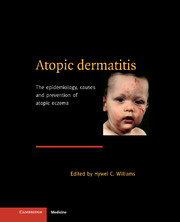Book contents
- Frontmatter
- Contents
- List of contributors
- Foreword Georg Rajka
- Preface
- Part I The nature of the problem
- Part II Descriptive studies which indicate the size of the problem
- Part III Analytical studies which point to causes of atopic dermatitis
- 8 Genetic epidemiology of atopic dermatitis
- 9 Fetal and perinatal origins of atopic dermatitis
- 10 Social factors and atopic dermatitis
- 11 The ‘old mother’ hypothesis
- 12 The possible role of environmental pollution in the development of atopic dermatitis
- 13 Atopic dermatitis in migrant populations
- 14 The role of inhalant allergens in atopic dermatitis
- 15 Dietary factors in established atopic dermatitis
- Part IV Intervention studies
- Part V Lessons from other fields of research
- Part VI Conclusions
- Additional information
- Index
- Plate section
13 - Atopic dermatitis in migrant populations
from Part III - Analytical studies which point to causes of atopic dermatitis
Published online by Cambridge University Press: 17 August 2009
- Frontmatter
- Contents
- List of contributors
- Foreword Georg Rajka
- Preface
- Part I The nature of the problem
- Part II Descriptive studies which indicate the size of the problem
- Part III Analytical studies which point to causes of atopic dermatitis
- 8 Genetic epidemiology of atopic dermatitis
- 9 Fetal and perinatal origins of atopic dermatitis
- 10 Social factors and atopic dermatitis
- 11 The ‘old mother’ hypothesis
- 12 The possible role of environmental pollution in the development of atopic dermatitis
- 13 Atopic dermatitis in migrant populations
- 14 The role of inhalant allergens in atopic dermatitis
- 15 Dietary factors in established atopic dermatitis
- Part IV Intervention studies
- Part V Lessons from other fields of research
- Part VI Conclusions
- Additional information
- Index
- Plate section
Summary
Introduction
Why study migrant groups?
Previous chapters in this book have suggested that the aetiology of atopic dermatitis (AD) is a complex interaction between genetic and environmental factors. The absence of any clear genetic markers for most cases of AD has meant that separating the effects of genetic versus environmental factors in cross-sectional, cohort or case-control studies has been extremely difficult to date. Some have used family history of atopic disease as a surrogate measure of the genetic influence of AD, but such a measure is far from adequate as close relatives, by definition, are likely to share a very similar environment. Twin studies have been useful in telling us something about the role of nature versus nurture (Schultz Larsen, 1986) but, as was pointed out in Chapter 8, these also have their limitations.
Another approach to separating the effects of genetics versus environmental factors is the study of genetically similar people who migrate from one country to another, where they might be exposed to a range of different environmental factors. The assumption underlying migrant studies is that, if genetically similar people who migrate from one country to another acquire a different risk of disease, the change in risk status might be attributable to environmental factors present in the adopted country. It seems very unlikely that genetic factors could account for changes in disease rates in migrant groups which occur over the span of a decade or one generation.
- Type
- Chapter
- Information
- Atopic DermatitisThe Epidemiology, Causes and Prevention of Atopic Eczema, pp. 169 - 182Publisher: Cambridge University PressPrint publication year: 2000
- 13
- Cited by



